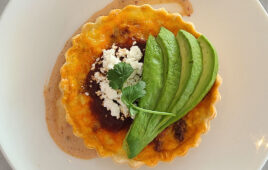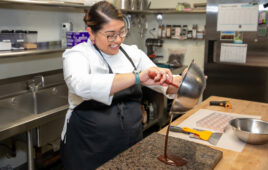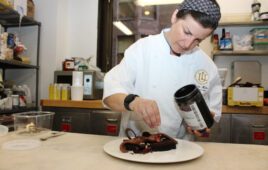Club pastry chefs are infusing dessert menus with creative dishes and delicious descriptions.
From sugary custards to chocolatey cakes, club dessert menus are a place of sweet joy. They are also often a club’s last chance to “wow” members and guests after a satisfying meal.

Laura Herman, Pastry Chef,
Conway Farms Golf Club
“Dessert isn’t a must-have for most people,” says Laura Herman, Pastry Chef of Conway Farms Golf Club (CFGC) in Lake Forest, Ill. “So the menu you place in front of your members after they finish their meals has to offer them something they can’t refuse.”
Herman is definitely doing something right at CFGC, as 80% of the club’s tables order dessert as part of their meals.
“Our menus tend to feature something chocolatey, something cakey, something fruity and something creamy,” says Herman, who tries to emphasis a well-balanced approach with her menus. “We don’t repeat ingredients and we shoot for around five options, plus ice creams, in-season.”
Out of season, CFGC scales back to three desserts, plus ice creams.
“The number of dessert items on the menu depends on how well the kitchen can execute them during busy production times, without compromising the quality of the dish,” Herman notes. “Five tends to be the most reasonable amount.”
Seasonality plays an important role in determining which desserts make the cut. “Seasonal fruit is a great way to showcase an ingredient that members crave,” says Herman, noting that summer desserts tend to be lighter, while winter desserts tend to be richer and warmer.
Pastry specialties featured on CFGC’s latest menu included a blueberry hand pie with almond nougatine and homemade vanilla bean ice cream; Meyer lemon cheesecake with a raspberry-strawberry compote and pistachios, and a chocolate cake with coconut milk jam and coconut almond-chip ice cream. Herman also featured three homemade ice creams—vanilla bean, double chocolate and mint chocolate chip—alongside homemade ice cream bars and green-apple sorbet.
How the options are presented is also an important part of Herman’s strategy.
“Flowery words don’t sell desserts,” she says. “An approachable menu with recognizable flavors and clear, understandable descriptions does.”
Because chocolate tends to sell itself, Herman typically lists that dish toward the bottom of her menu, to make sure diners read through the other options before settling on chocolate.
Servers also play a critical part in the success of dessert menus.
“Your servers need to know what’s on your dessert menu, just like they need to know what’s on your dinner menu,” says Herman. “They have to be able to explain the ingredients and flavors, and to offer suggestions.”
To educate servers, CFGC includes pastry in its nightly pre-shift meeting.
“Get your servers excited about what you’re creating,” says Herman, who has been with the club for six years and has steadily increased and improved the pastry side of the operation through her own excitement and passion.
“We’re fortunate to be able to change our menu frequently, but if a club doesn’t have a dedicated pastry department, they shouldn’t change the dessert menu nearly as often,” she adds. “It’s more useful to do a few desserts really well than to have a ton of variety.”
She suggests focusing on classic desserts, like cheesecake and chocolate cake, and infusing them with seasonal touches.
“Even making half of your dessert menu in-house will impact your sales,” she says. “But keep it simple. A perfectly executed dessert is satisfying on many levels.”




